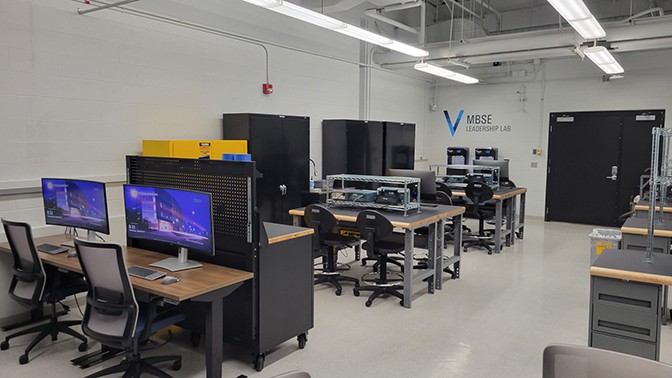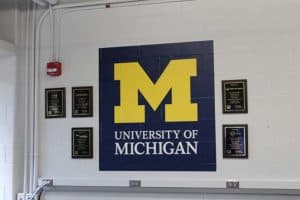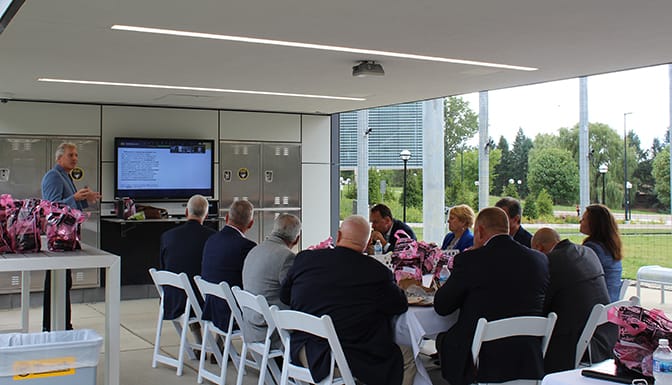
Aerospace Engineering unveils new Model-Based Systems Engineering Leadership Lab
First-of-its-kind facility enables student collaboration on projects to design, build, test, and fly aircraft using MBSE and industry-proven tools and processes.

First-of-its-kind facility enables student collaboration on projects to design, build, test, and fly aircraft using MBSE and industry-proven tools and processes.
Engineering students at the University of Michigan will have some new resources this year, in part due to the opening of the high-tech Model-Based Systems Engineering (MBSE) Leadership Lab on the ground floor of the FXB Building.
A first-of-its-kind facility for Aerospace Engineering students, the lab will provide a flexible product development and teaming space where students can collaborate in cross-campus projects to design, build, test, and fly aircraft using Model-Based Systems Engineering and industry-proven systems engineering tools & processes.

The lab packs a lot into the 1,000 square foot facility, accommodating a requirements-through-manufacturing MBSE lab sequence, hardware and software design, computer-aided design (CAD), 3D printing, flow simulation, structural simulation, product manufacturing and assembly, as well as team presentation and meeting space.

Funding for the facility comes largely from corporate sponsors, with major investments from Siemens, Collins Aerospace and Pratt & Whitney, Leidos, and the Francois-Xavier Bagnoud (FXB) Flight Institute.
George Halow, an aerospace engineering professor of practice in the College of Engineering, led the development of the lab, putting together a portfolio of investors, starting with Siemens. “Getting Siemens as the initial partner was a dream come true,” he shares. “When I was plugged in to the right people and told them what we were doing, they jumped in with amazing technical advice, mentoring, and ultimately the first funding contribution for the lab.”
“The increasing pace of innovation in Advanced Air Mobility, high speed flight, new defense programs and space exploration will require engineers with Model-Based System Engineering skillsets, which is why we are excited to partner with the team at University of Michigan to develop this lab and curriculum,” said Dale Tutt, Vice President of Aerospace and Defense, Siemens Digital Industries Software, “Together we can help prepare the next generation of engineers to harness the promise of this innovation and deliver the future of aerospace.”

Halow also leveraged the department’s Industry Advisory Board (IAB), getting quick participation from Raytheon, the aerospace corporation that includes Collins Aerospace and Pratt & Whitney, both with members on the IAB. Halow comments, “Our industry advisors see such value in how this space provides such useful hands-on experience for the students that they ultimately want to hire. We’ve gotten fantastic support, and it continues to roll in.”
The increasing pace of innovation in Advanced Air Mobility, high speed flight, new defense programs and space exploration will require engineers with Model-Based System Engineering skillsets, which is why we are excited to partner with the team at University of Michigan to develop this lab and curriculum.
Dale Tutt, Vice President of Aerospace and Defense, Siemens Digital Industries Software
Mauro Atalla, Sr Vice President, Engineering & Technology for Collins Aerospace serves on the IAB and shares, “Model-based systems engineering is critical to advancing more sustainable aircraft, a more connected ecosystem, and intelligent and more autonomous solutions that will shape the future of the aerospace and defense industry. Collins Aerospace and Pratt & Whitney are thrilled to support the next generation of engineers who will use modern systems engineering methods and tools to create the innovative and optimized solutions our customers look for.”
Also on the IAB is alumnus Artie A. Mabbett (M.S.E ’01), Vice President & Deputy Director at Leidos, who connected the dots between Leidos corporate goals and opportunities to enrich student experiences at U-M. Mabbett comments, “MBSE and Digital Engineering are critical elements to a solid systems engineering approach that will dramatically accelerate our ability to design, prototype and field advanced capabilities for our Department of Defense customers. Not only does Leidos get to collaborate with world class faculty, staff and industry partners but it helps build a pipeline of future leaders.”
The lab supports a changing curriculum thread led by Halow and under the direction of aerospace department chair Tony Waas to develop new courses in leadership and professionalism, engaging students in topics they will experience in a practical aerospace career. This first course, Systems Engineering Leadership, will ultimately morph into three MBSE-based systems engineering courses with a comprehensive set of teachings in complex product development.
Waas knew the lab would be an important focal point and created space for the facility on the coveted ground floor of the FXB Building, home of the aerospace engineering department. Waas states, “This lab will provide an important facility for all students, and we want it to be easily accessible and useful for them and visible for our faculty, staff, alumni and donors. The support from our corporate partners for this project, particularly during the pandemic when the aerospace industry was hard hit, has been astounding.”
While students are just now gaining access as the academic year begins, Morgan Serra, an aerospace rising junior, spent her summer as a key developer and builder of the lab. “It has been an honor to be a part of developing a lab with such astounding potential. This lab space—unique in its intersection of CAD workstations, manufacturing and assembly resources, and design presentation capabilities to take students through an entire product development process—is a gamechanger for Michigan’s aerospace engineering curriculum and community. I can already see myself working in this lab outside of class, applying course concepts, and learning from and working side-by-side with the many project teams.”

The lab was unveiled during a small, special event with executive leaders from the core sponsor companies on Thursday, September 9th. The course and lab, in close partnership with sponsors and other companies, will usher in a new paradigm in MBSE and systems engineering teachings at the undergraduate level, and will help continue the rich tradition of the “Michigan Difference” in engineering education.